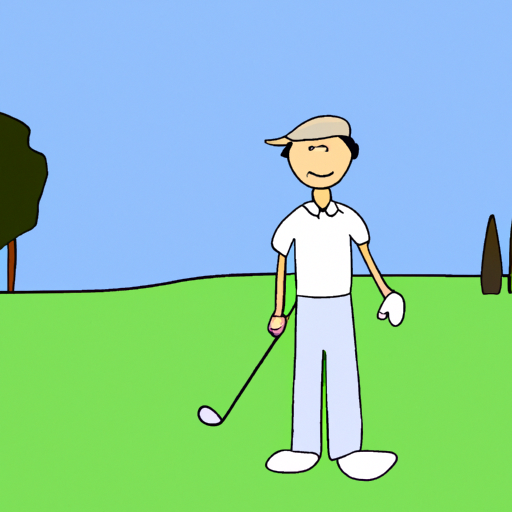Unlocking the Secrets to a Perfect Golf Swing: Tips for Beginners
Are you tired of your golf swing feeling like a gamble every time you tee up? Let's change that. In just a few short paragraphs, I'll introduce you to the key strategies that can transform your inconsistent swings into a series of well-executed shots. Whether you're in a rush or have time to dive deep, the key takeaways and FAQ section at the bottom of this article will serve as your quick reference guide. Get ready to tee off with confidence and make every swing count.
Are you feeling overwhelmed by the sheer volume of advice out there on perfecting your golf swing? I know the feeling. It's like you're standing at the tee, club in hand, with a cacophony of "do this, not that" echoing in your mind. It's enough to make your head spin before the ball ever does. But what if I told you that mastering your golf swing, even as a beginner, doesn't have to be a nerve-shattering ordeal? That's right, with the right guidance, tapping into the insider information, and focusing on the tried-and-true fundamentals, you can transform that tentative first swing into a bone-crunching drive down the fairway.
The problem with most first-time golf swing tips is that they're riddled with mumbo-jumbo and confusing jargon. They make you feel like you're trying to crack the code to some secret golfing society. But here, we're going to slash through that complexity and lay it out in plain English. I'm going to share with you the same wickedly effective tips that helped me go from spraying shots like a rainbird sprinkler to confidently teeing off with the poise of a seasoned pro. We'll dive into the top fundamentals, the proper sequencing, and the beginner tips that are so simple yet so incredibly transformative, they're almost like discovering a hidden power you never knew you had.
As we embark on this journey together, I'll be right there with you, up close and personal, sharing my own blood and guts stories from when I was a rank beginner. We'll explore the untapped resources and mega-valuable insights that will supercharge your swing and boost your confidence on the course. So, are you ready to leave behind the frustration and step into the realm of jaw-dropping drives and nerve-shattering accuracy? Let's tee off this adventure with a clear focus on what truly matters – your success in the game of golf. And remember, this isn't just about hitting a ball; it's about unlocking a part of you that's been eager to show its full potential. After all, you're here for the breakthroughs that will make your golf buddies watch in awe, right?
Let's get started.
 Capture the essence of a perfect swing with our first-time golf tips.
Capture the essence of a perfect swing with our first-time golf tips.What Are the Top Fundamentals Needed for a Great Golf Swing?
When I first gripped a golf club, I felt a mix of excitement and sheer terror. There I was, an absolute beginner, standing on the green, surrounded by players who could probably hit the ball in their sleep. But, as I learned, and what I'm about to share with you, is that a great golf swing isn't about strength or even natural talent; it's about mastering the fundamentals. So, let's break down these essentials, and I'll sprinkle in a bit of my journey from a stumbling novice to someone who can now hit the fairway with confidence.
Grip: The Foundation of Your Swing
- Neutral Grip: This is where it all begins. I remember adjusting my hands repeatedly, trying to find that sweet spot. It's crucial to have a grip that's neither too strong nor too weak. Imagine holding a bird – firm enough that it can't fly away, but gentle enough not to harm it.
- Consistency: Once you find your grip, stick with it. Consistency is key. I used to change my grip almost every game, and it was like taking one step forward and two steps back.
Stance: Your Power Stance
- Shoulder Width: Your feet should be shoulder-width apart. I used to stand too wide, thinking it would give me more power, but it only led to a loss of control.
- Ball Position: For beginners, placing the ball in the middle of your stance is a safe bet. As you get more comfortable, you can adjust this depending on the club you're using.
Posture: The Golden Posture
- Straight Back: Keep your back straight, but not rigid. I learned the hard way that slouching leads to a world of inconsistency.
- Bend at the Hips: This was a game-changer for me. Bending from the hips, not the waist, allows for a better swing path.
Backswing: The Wind-Up
- Slow and Steady: Rushing your backswing is like trying to sprint before you can walk. I used to whip the club back quickly, which only led to disaster.
- Full Rotation: Ensure your shoulders turn fully. It's not just about the arms. I found that visualizing my back facing the target at the top of my swing helped immensely.
Downswing: Unleashing the Power
- Hip Lead: Start the downswing with your hips, not your hands. This was a tough one for me, but when I got it right, the difference was night and day.
- Downward Strike: Think of the downswing as a whip cracking. The power comes from a smooth, downward action, not from trying to 'lift' the ball into the air.
Follow-Through: The Grand Finale
- Complete the Swing: Don't stop once you hit the ball. Follow through to a full finish, with your chest facing the target. It felt awkward at first, but now it's second nature.
Mental Game: The Invisible Club
- Focus: Clear your mind before each swing. I used to be so worried about the outcome that I'd tense up, ruining my swing before it even started.
- Visualization: Before every swing, I visualize exactly where I want the ball to go. It's like setting a GPS for your golf ball.
Incorporating these fundamentals into my routine didn't happen overnight. It took patience, practice, and a few humbling moments of being 'that person' who missed the ball entirely. But as I pieced together these elements, my swing transformed. I went from being the one who everyone waited on to the one leading the pack down the fairway.
Remember, it's not about having the most expensive clubs or the flashiest shoes; it's about nailing these basics. So, take these tips, hit the driving range, and prepare to amaze yourself. And just when you think you've got it all figured out, you'll discover there's always more to learn. Isn't that exciting?
Now, let's move on to the next fundamental that might just be the secret sauce to your swing. Are you ready to dive in?
How Do I Properly Sequence My Golf Swing?
Sequencing your golf swing is like conducting an orchestra; every element must come in at the right time for the symphony to be a masterpiece. I'll never forget the day when my coach told me that power in a golf swing is like a chain reaction; everything is linked. If one link is out of sync, the whole swing suffers. So, let's break down the sequence of a golf swing, step by step, ensuring that your swing is not just a series of motions, but a fluid, harmonious action.
The Takeaway
- Start Slow: The takeaway sets the tone for your swing. I used to jerk the club back in a hurry, which threw off my entire sequence. Now, I start with a smooth, controlled movement.
- Clubface Control: Keep the clubface square to the ball as long as possible. This was a tip from a seasoned pro I met at a charity golf event, and it's stuck with me ever since.
The Transition
- Pause at the Top: There's a moment at the top of your backswing that should feel like a brief pause. This allows for the necessary change of direction. I think of it as the calm before the storm.
- Weight Shift: Begin transferring your weight from the back foot to the front. It's a subtle but crucial move. I used to ignore this and ended up with a swing that was all arms and no power.
The Downswing
- Hips Lead: Start the downswing with your hips, not your hands. This was a revelation for me. Once I got the hang of it, my shots became more powerful and accurate.
- Arms Follow: Let your arms follow the motion initiated by your hips. They should feel almost like they're being pulled by the rotation of your body.
Impact
- Flat Left Wrist: At impact, your left wrist (for right-handed golfers) should be flat. This ensures solid contact with the ball. I used to flip my wrists, which led to all sorts of erratic shots.
- Head Down: Keep your head down through impact. I had a habit of looking up too soon, eager to see where the ball would go, often with disappointing results.
The Follow-Through
- Complete the Turn: Your body should continue to turn until your chest faces the target. I remember hitting what I thought was the perfect shot, only to be betrayed by a lazy follow-through.
- Balance: Finish in a balanced position, with your weight fully shifted onto the front foot. If you're falling backward, it's a sign that your sequence was off.
The Rhythm
- Consistent Tempo: The rhythm of your swing is as important as the sequence. I used to rush my swing in tense situations, which only compounded my errors. Now, I count in my head, ensuring a consistent tempo.
Mental Checklist
- Pre-Shot Routine: Develop a pre-shot routine that includes a mental run-through of your swing sequence. This primes your muscle memory and focus. I have a little mantra I recite, which helps me stay in the zone.
Properly sequencing your golf swing is a delicate dance that requires practice, patience, and a bit of personal flair. I've spent countless hours on the range, hitting balls until the sun dipped below the horizon, all in pursuit of that perfect sequence. And when it all comes together, it's like magic; the ball soars, the crowd (or just the squirrels, in my case) goes wild, and for a moment, you feel like a golfing deity.
So, take these insights, head to the range, and work on that sequence. Remember, it's about smooth transitions, not jerky movements. And just when you think you've got it, you'll find a new layer to explore, a new tweak to make. Isn't that the beauty of golf? Now, how will you benefit from nailing the perfect sequence? Let's find out in the next section, shall we?
What Are Some Great Beginner Golf Swing Tips to Follow?
Embarking on the journey of golf can feel like you're learning a new language, one filled with strange terms and nuanced rules. I remember my first swing—how I gripped the club like I was holding on for dear life and swung with all the grace of a sledgehammer. It was a humbling start, but with these beginner tips, you'll be on your way to a swing that's both effective and envy-worthy.
Grip It Right
- Interlocking or Overlapping: Choose a grip that feels comfortable. I started with the interlocking grip because it gave me a sense of unity with the club.
- Pressure: Your grip should be firm yet relaxed. Imagine holding a bird—tight enough it can't fly away, but gentle enough not to harm it.
Stance and Posture
- Feet Shoulder-Width Apart: This provides balance. I used to stand too wide, thinking it would give me more power, but it only led to a rigid swing.
- Slight Knee Bend: This adds flexibility. I remember the advice from an old-timer at the club: "Bend your knees; it's a swing, not a salute."
- Straight Back: Keep your back straight, but not rigid. A pro once told me to imagine a string pulling me up from the top of my head.
The Backswing
- Slow and Steady: Rushing your backswing can throw off your timing. I learned to count to three during my backswing to keep it slow.
- Don't Over-Rotate: Your back should turn, but don't let your front shoulder dip. I used to twist like a pretzel, which was neither effective nor comfortable.
The Downswing
- Lead with Hips: Start the downswing with your hips, not your hands. It was a game-changer when I realized my hips were the key to power.
- Eye on the Ball: Keep your eye on the ball until impact. I used to look for where I wanted the ball to go, often resulting in a miss-hit.
The Follow-Through
- Complete the Motion: Swing through the ball, not at it. I imagine my club needs to reach a target far beyond the ball.
- Balance: End with your weight mostly on your front foot and your body facing the target. I used to fall backward after a swing, a sure sign I was off-balance.
Mental Game
- Visualize: Picture the shot before you take it. Visualization was a tip from a sports psychologist I met, and it's been invaluable.
- Routine: Develop a pre-shot routine to calm nerves and set the stage. I have a little wiggle I do—it looks silly, but it sets my mind right.
Practice Drills
- Half-Swings: Practice half-swings to focus on form before power. I spent weeks on this, and it paid off.
- Putting First: Start with putting to develop a feel for the greens. A local pro told me, "Putting is like whispering to the ball."
For beginners, the key is to build a swing that feels natural and is repeatable under pressure. I've been through the wringer, from spraying shots like a rainbird sprinkler to finally finding a rhythm that works. It's a process, one filled with nerve-shattering moments and bone-crunching reality checks, but also with jaw-dropping breakthroughs and the pure, unadulterated joy of a well-struck ball.
Remember, every pro started as a beginner, and every swing is a step towards mastery. So, grab your clubs, hit the range, and embrace the journey. And remember, the real secret weapon is perseverance. Are you ready to put these tips into action and dominate the greens? After all, what more could we ask for? Hold on! We're not done yet. Let's see what else we can uncover to elevate your game.
Key Takeaways for First-Time Golf Swing Tips
Embarking on your golf journey can be as thrilling as it is daunting. But remember, the path to a confident and effective golf swing is paved with patience, practice, and a sprinkle of insider knowledge. Here are the key takeaways to keep in your golf bag:
Grip: Find your grip style and maintain a pressure that's firm yet gentle.
Stance: Stand with feet shoulder-width apart, knees slightly bent, and back straight.
Backswing: Keep it slow and controlled, avoiding over-rotation.
Downswing: Lead with your hips and keep your eyes on the ball until impact.
Follow-Through: Complete your swing with balance, aiming to finish with your body facing the target.
Mental Game: Visualize your shots and establish a pre-shot routine to stay calm and focused.
Practice: Engage in drills that emphasize form, such as half-swings and putting.
Action Plan
Commit to Practice: Schedule regular practice sessions, focusing on the fundamentals outlined.
Seek Feedback: Don't shy away from asking for advice or getting a few lessons from a pro.
Stay Patient: Understand that progress takes time and celebrate small victories along the way.
Equipment Check: Ensure your clubs are suited to your style and stature for optimal performance.
Encouragement to Take Action
Now that you're armed with these tips and insights, it's time to take action. Head to the driving range, apply what you've learned, and watch as your golf swing transforms from 'first-time' to 'fine-tuned'. Remember, every swing you take is an opportunity to improve, to tweak, and to edge closer to the golfer you aspire to be.
So, are you ready to step up to the tee with confidence? Will you commit to the practice that turns beginners into enthusiasts and enthusiasts into experts? Isn't it time to see just how far your newfound knowledge can take you?
Let's not let this be another 'if only' moment. Grab your clubs, and let's make your first swing the start of something great. After all, isn't it your turn to experience the thrill of a perfect drive? How will you take these tips and make them work for you on the course?
First Time Golf Swing Tips FAQ
What is the proper way to grip a golf club?
What is the proper way to grip a golf club?
The proper grip involves placing the lead hand (left hand for right-handed golfers) on top of the club with the thumb pointing down the shaft, and the trailing hand below it, interlocking or overlapping the lead hand's pinkie with the index finger.
How should I position my body for a golf swing?
How should I position my body for a golf swing?
Stand with your feet shoulder-width apart, knees slightly bent, and your back straight. Your body should be parallel to the target line, and the ball should be positioned in line with the inside of your lead foot for longer clubs and more towards the center for shorter clubs.
What are the key components of a good golf swing?
What are the key components of a good golf swing?
A good golf swing includes a balanced stance, a smooth takeaway, a full backswing where the lead arm is straight, a downward strike on the ball, and a follow-through where the body faces the target.
How can I improve my golf swing as a beginner?
How can I improve my golf swing as a beginner?
Start with the basics: ensure you have the right grip, stance, and posture. Practice your swing slowly and focus on the mechanics before increasing speed. Consider taking lessons from a professional to get personalized advice.
What are some common mistakes beginners make with their golf swing?
What are some common mistakes beginners make with their golf swing?
Common mistakes include gripping the club too tightly, swinging too hard, not rotating the hips, lifting the head during the swing, and not following through.

















